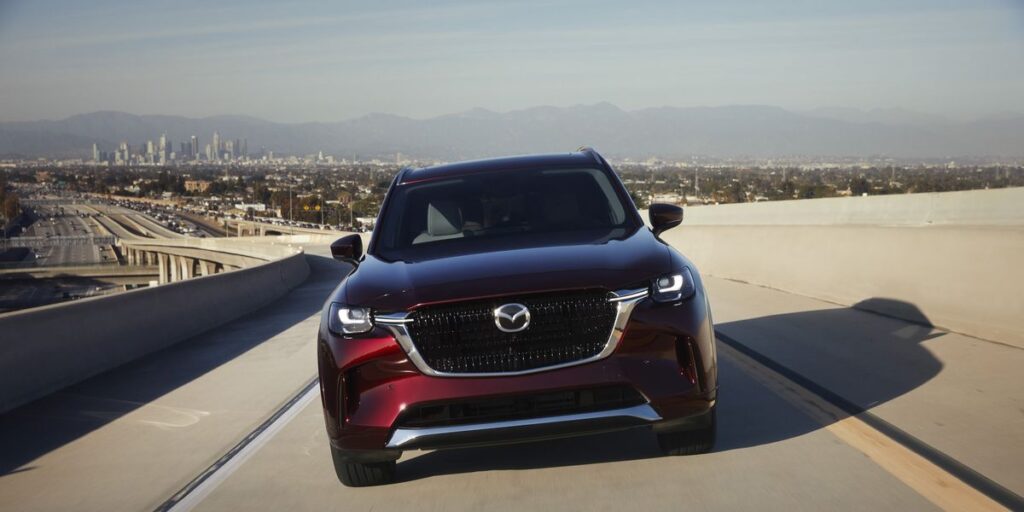Why Mazda's CX-90 Had to Have an Inline-Six

From the June 2023 issue of Car and Driver.
When Mazda’s CX-90 mid-size SUV broke cover earlier this year, behind its smile of a grille was an all-new turbocharged inline six-cylinder gasoline engine. The decision to design and build an all-new gas engine is a complicated and costly one for any carmaker, and not without risk. That’s especially so for a small manufacturer like Mazda, and doubly so at this point in time, as one car company after another announces that they’ll be phasing out internal-combustion powerplants in the coming years on the way to an all-electric future.
Mazda’s new turbo inline-six.
Mazda
Mazda could have powered its new SUV with a turbocharged four-cylinder; it currently offers a 2.5-liter turbo-four in several models and employs a version of that engine in the CX-90 PHEV. But the company decided that nothing other than a gasoline six would do for the rest of the line, and the new engine had to have its cylinders arranged in a row rather than a V.
Why? Because Mazda has been pushing hard in recent years to nudge its brand upmarket, and premium brands including BMW, Mercedes-Benz, Land Rover, and Jeep all have inline-sixes in their lineups. The CX-90 is the company’s flagship, we were told, a statement that Mazda wants to be taken seriously by buyers considering upscale brands.
Designed around a Six
The choice of an inline-six was an integral part of the new SUV’s design from the outset. Mazda reasoned that its SUV flagship needed to be on an-all new rear-drive platform to compete. (Rumor has it that a sedan will be built on this architecture as well.) Going rear-drive would enable a long dash-to-axle ratio—the distance from the dashboard to the front axle—that gives premium vehicles their more elegant rear-drive proportions. The new platform also enabled the CX-90’s engine to be located longitudinally rather than transversely, as it would have been in a front-drive configuration.
The longitudinal-engine configuration opened up the possibility for the straight-six, which is longer than either a four-cylinder or a V-6 and virtually impossible to fit transversely in a front-drive vehicle’s engine bay. Inline-sixes are narrower than V-6s, which left enough additional space up front to fit a control-arm front suspension. Mazda believed the superior geometry of a control-arm setup would help grace the CX-90 with added agility and crisper handling than the more commonly used struts. Inline-sixes are also inherently smoother than V-6s, another plus for a vehicle intended to draw buyers from the premium category.
Tuned for Torque
Mazda’s new inline-six displaces 3.3 liters, is boosted by a single turbocharger, and incorporates a 48-volt hybrid-assist system that can add 17 horsepower and 113 pound-feet of torque. The new six comes in two strengths. CX-90 Turbo models get a version that makes 280 horsepower at 5000 rpm and 332 pound-feet of torque at 2000 rpm. For top-spec Turbo S models, the power goes up to 340 horsepower at 5000 rpm and 369 pound-feet at 2000 rpm.
Both variants are identical internally. Their differing power outputs come down to how much boost the turbos provide and the octane of the fuel they’re tuned to run on. The lower-power six inhales about 14 pounds of boost and lives happily with regular fuel. Switching it to premium does not add any ponies to its stable. Mazda turns up the boost to about 19 pounds on the higher-output six and tunes it to take advantage of premium fuel. You can save money by running that one on regular fuel, though. Do that and horsepower drops to 319, but torque remains unchanged.
While other makers have settled on 3.0 liters as the right displacement for their inline-sixes, Mazda went 10 percent larger. The new engine also features a 12:1 compression ratio, which is high for a boosted mill. That, along with the larger displacement and the hybrid-assist system, seems aimed at buttressing low-rpm torque and throttle response when the engine is off boost.
It certainly felt that way when we drove the CX-90 Turbo S at its debut event in San Francisco. At lower speeds in city traffic throttle response was crisp, and the powertrain felt torquey and responsive. The new engine moves the CX-90 along briskly, virtually absent boost lag. Leg it, and it pulls solidly and sounds sweetly melodic. Acceleration tails off somewhat as the tach sweeps past the lowish 5000-rpm power peak, but that’s okay; the CX-90 isn’t playing performance SUV.
Mazda’s new engine is well tailored to an SUV that balances refinement, luxury, and driver involvement adroitly. The new six does just what it’s supposed to do.

Director, Buyer’s Guide
Rich Ceppos has evaluated automobiles and automotive technology during a career that has encompassed 10 years at General Motors, two stints at Car and Driver totaling 19 years, and thousands of miles logged in racing cars. He was in music school when he realized what he really wanted to do in life and, somehow, it’s worked out. In between his two C/D postings he served as executive editor of Automobile Magazine; was an executive vice president at Campbell Marketing & Communications; worked in GM’s product-development area; and became publisher of Autoweek. He has raced continuously since college, held SCCA and IMSA pro racing licenses, and has competed in the 24 Hours of Daytona. He currently ministers to a 1999 Miata and a 1965 Corvette convertible and appreciates that none of his younger colleagues have yet uttered “Okay, Boomer” when he tells one of his stories about the crazy old days at C/D.



